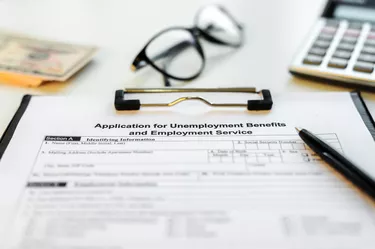
Going on unemployment insurance can be a frightening and intimidating process. Between correctly filling out all the forms for your initial claim for unemployment assistance, answering follow-up questions with additional information and navigating your ongoing job search responsibilities, there's a lot to think about before you even begin to cope with the loss of your job and collect unemployment claim benefit payments.
As you navigate all of this as a claimant, you'll hear many terms that might be confusing. Some of them are "highest quarter" and "unemployed quarter." Unemployed quarters are critical because they help state unemployment departments determine your eligibility for benefits and benefit amounts. It helps to learn about an unemployed quarter and how state employees use it through the unemployment application and payment processes.
Video of the Day
Video of the Day
What Is an Unemployed Quarter?
When unemployment agencies refer to quarters, they're measuring a length of time, which is one-quarter of a year, or three months. The four quarters of the benefit year are:
- First quarter: January, February and March
- Second quarter: April, May and June
- Third quarter: July, August and September
- Fourth quarter: October, November and December
An unemployment quarter is the same as a quarter of a year, or a three month period of time.
How Does Unemployment Use Quarterly Earnings to Determine Benefits?
According to the U.S. Department of Labor, you should consider whether you're eligible for unemployment insurance benefits whenever you lose a job. When you apply, the Department of Labor will collect a lot of information from you, including total wages information from pay stubs, tax returns and your employer. It considers your pay in the first four of the last five complete quarters to determine your benefits.
Therefore, the date of your termination of employment is crucial. Suppose you lost your job on April 15, 2022. Unemployment would look at your income from January 1 to December 31, 2021. If you were terminated on September 30, 2020, the Department of Labor would look at your qualifying income from April 1, 2019 to March 30, 2020.
It takes your average income from those four quarters, called your base period, and pays you a percentage of those base period wages. In most states, you're entitled to 26 weeks worth of unemployment benefits, or half a year. Your state determines your annual monetary cap by multiplying your maximum weekly unemployment pay by 26. You may receive more than 26 payments in one year if you receive partial UI benefits or partial weeks.
What Other Information Is Used to Determine Unemployment Benefits?
Besides the obvious identifying information (Social Security number, date of birth and so on), departments of unemployment use several other pieces of data to determine your eligibility and the amount of your unemployment compensation benefits. This information varies from state to state, but there are some consistent similarities.
First, each state pays a different percentage of your base period income, and many states have maximum allowances or a maximum number of weeks for your UI claim. Sometimes, your income level may put you in a certain bracket, which helps determine the level of support you will receive from the government.
Therefore, two main factors determine your unemployment benefits: your state's unemployment benefit levels and your income from your employer over the first four of the past five quarters. Some people are surprised to learn that family size, lifestyle, term of employment and other factors don't matter.
Who Qualifies for Unemployment?
According to the United States Department of Labor Employment & Training Administration, most citizens and some legal residents of most states in the U.S. are entitled to unemployment benefits if they meet certain conditions. Typically, they must have been employed for a certain period to file a new claim. Their termination must also be through no fault of their own.
It's important to remember that the rules that applied during the COVID-19 pandemic have almost entirely expired. Despite that, many states' unemployment sections of their departments of labor are still dealing with paperwork and backlog. If you think you were entitled to a certain amount of benefits benefits you did not receive, contact your state's department of unemployment compensation and go from there.